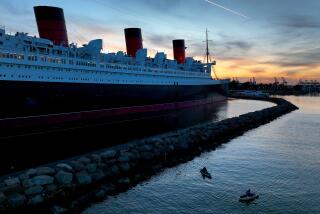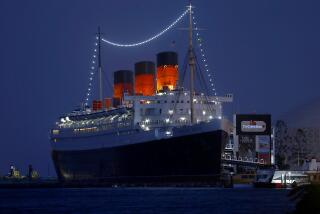Historic Ship’s Social Saloon Lives On
- Share via
BELVEDERE, Calif. — The social saloon of the China, pride of San Francisco-based Pacific Mail Steamship Co. in the late 1800s, has been saved from the wrecking ball and will soon be a public museum.
“It’s the only one of its kind in the world,” said Beverly Bastian, honorary president of the Belvedere-Tiburon Landmarks Society. “It was just too beautiful to destroy.”
The National Trust for Historic Preservation says the cabin is the only 19th-Century ship’s passenger accommodation known to exist, according to Bastian. The trust has made a restoration grant of $62,500, which will be matched by the society.
The 20-by-40-foot saloon, which features arched beams, a cathedral-like ceiling and etched glass, was lifted from the abandoned side-wheeler in 1886 and bought by J. T. Keefe, port captain of the Corinthian Yacht Club in Marin County.
Although the rest of the China went up in flames at a marine crematory in Tiburon, the cabin and a pair of staterooms were barged to Belvedere Cove and became a residence.
What quickly became known as the China Cabin rested on the beach for nearly 90 years until city officials slated it for demolition in 1978 as part of a waterfront plan.
Members of the Landmarks Society convinced city leaders to let them take over the cabin on condition that no city money be spent. Restoration has taken more than six years and grants and donations of almost $500,000.
A Stancion Society was formed to raise money. The cabin was elevated onto pilings, and a deck-like walkway was built to surround the white saloon.
Gold Leaf Restored
“Every time you do a restoration, you find something else that needs to be done,” Bastian said.
More than 20 layers of paint were stripped before crews reached the gold leaf on the floor-to-ceiling moldings and walnut pillars.
Gold Leaf Inc. of Washington restored the gold leaf. Workers took three weeks to complete the job in April, using just three ounces of gold.
The project has won the support of the alumni and faculty of the Webb Institute of Naval Architecture in New York, founded by William Webb, who designed the China. The saloon is all that is left of the work of Webb, one of America’s foremost designers of clipper ships.
The China, built in 1866, was then the largest wooden, ocean-going commercial vessel afloat, offering luxurious and spacious accommodations.
The ship came around Cape Horn in 1867 and made regular 22-day runs across the Pacific until 1879. The China was only one of four sister ships to survive the rigors of the seas.
Plans calls for the cabin, which was relocated on the beach to face San Francisco, to open as a museum sometime in July.
The saloon, which will seat 55 people, will also be rented for private parties and receptions. The staterooms, once occupied by the ship’s chief engineer and surgeon, will be used as an office and restroom.
More to Read
Sign up for The Wild
We’ll help you find the best places to hike, bike and run, as well as the perfect silent spots for meditation and yoga.
You may occasionally receive promotional content from the Los Angeles Times.






